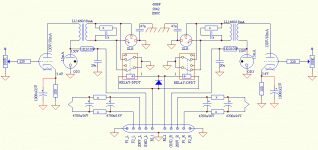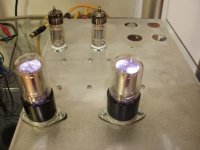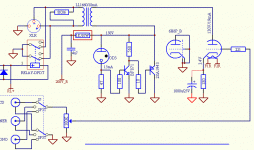No experience with the 1660. I use the 1689 with great results, but not LTP. You might try scrapping the CCS in the cathodes and go for straight resistor. Following thread has some theory on this (post 10):
http://www.diyaudio.com/forums/tube...pleted-phase-shift-questions.html#post1684640
http://www.diyaudio.com/forums/tube...pleted-phase-shift-questions.html#post1684640
Cheers zigzagflux. Trashing the CS perhaps I should happily try, but I am now totally 'divorced' from my former LTP design. I think the LTP needs low current, high mu triodes of the likes of 12ax7 and painstaking attention to a -ve power supply.
I intend to go the SE route now, hence this thread. To my ears, in general SE sounds better. But let's not get into that, as there are as many opinions as individuals really...
I intend to go the SE route now, hence this thread. To my ears, in general SE sounds better. But let's not get into that, as there are as many opinions as individuals really...
I am now totally 'divorced' from my former LTP design.
Very interesting. My experience is purely anecdotal but some time this year i built an ARC REF3 clone: CCSed LTP 6H30 into a couple of cathode followers for balanced operation. The CCS was just a single fet and the original source of Vneg - a 3-terminal reg. Didn't like the sound much - good bass but very dull highs. Suppliying Vneg from a Jung reg improved things a bit but not enough. Listened to it with the followers bypassed as well - a bit more transparent, less bass but still strange mids and highs. Parts quality was pretty good so that was definitely not to blame. The measurements came all top notch and distortion was similar to the advertised specs. Until now i assumed the blame lay with the operating points of the 6H30. 5mA is just ridiculous for this tube. Could the LTP really have a specific sound some of us dislike? So many preamps use it, not to mention power amp phase splitters.
Last edited:
Analog_sa, everything you say I could have written for my design! We picked very similar topologies, and I had thoroughly studied the ARC designs. Indeed excellent measurements, excellent bass but hard, uninviting middles and virtually non-existent top-end.The CCS was just a single fet and the original source of Vneg - a 3-terminal reg. Didn't like the sound much - good bass but very dull highs. Suppliying Vneg from a Jung reg improved things a bit but not enough. Listened to it with the followers bypassed as well - a bit more transparent, less bass but still strange mids and highs. Parts quality was pretty good so that was definitely not to blame. The measurements came all top notch and distortion was similar to the advertised specs.
It is so good (and quite rare) to come to such close agreement with somebody else findings. Even more since I also believe the rest of the circuitry and passive components were capable of much better performance.
In the end, my conclusion was that I wasn't listening to the tubes AT ALL, the CS had dominated the sound. All kinds of simple jfet, cascode bjt, cascode fet-mosfet etc were tried. Various -ve PS schemes, too. To me, high-Z circuits have a tendency for unpredictability. By the way, this does not go for a common-cathode grid input, since the tube's other two electrodes are relatively low-Z.
I am not sure there are many circulating preamps based solely on a LTP. ARC has them of course, but I have heard strangely bloated sounds by them-not necessarily bad, but not too much to my liking either.
Granted, many use them as phase splitters in power amps, but then they do not operate in isolation, they are usually enclosed in feedback loops. And not all push-pull designs produce pleasing noises.
My vote is for SE.
hey-hey!!!,
I built a resistive loaded LTP 12B4 linestage a bit ago. Aside from the sensitive/microphonic tubes and a shaking chassis it was very nice. It is getting rebuilt with two chassis to get rid ov the shaking issue. It had motor run film caps as outputs and drove an active crossover very nicely. Worked well with trioded EL86 too and I'll probably try it with 6AH4 while I am at it( the amplifier chassis will be an easy swap to run the octals....no need to build another PS ).
Can't say I experienced any of the issues y'all complain of, not even close. It sounded just like a SE 12B4...
cheers,
Douglas
I built a resistive loaded LTP 12B4 linestage a bit ago. Aside from the sensitive/microphonic tubes and a shaking chassis it was very nice. It is getting rebuilt with two chassis to get rid ov the shaking issue. It had motor run film caps as outputs and drove an active crossover very nicely. Worked well with trioded EL86 too and I'll probably try it with 6AH4 while I am at it( the amplifier chassis will be an easy swap to run the octals....no need to build another PS ).
Can't say I experienced any of the issues y'all complain of, not even close. It sounded just like a SE 12B4...
cheers,
Douglas
Douglas,
what stood between the cathodes and gnd or -ve rail? And am I correct to assume that you fed it with balanced signal?
A battery-biased DC2540/3545 cascode MOSFET ccs is in the tail. It was fed SE. Plate loads of 20k, B+ of 480, and nearly 20 mA idle per tube. Negative rail was serving dual duty as the DC supply to the heaters, positive end grounded.
cheers,
Douglas
->quite similar to mine.A battery-biased DC2540/3545 cascode MOSFET ccs is in the tail. It was fed SE. Plate loads of 20k, B+ of 480, and nearly 20 mA idle per tube. Negative rail was serving dual duty as the DC supply to the heaters, positive end grounded.
------------------------->>>>>>>>>>>>>>>>>>>>>>>>>Beats me!Can't say I experienced any of the issues y'all complain of, not even close. It sounded just like a SE 12B4...
Still working on the details...this is what I plan to be working on. PS will be on a separate chassis.
Possible tubes are 6H6P, 6H30, 5842 and E88C (different bulb per channel). I guess usual suspects like the 12B4 may also be tried. I'll kick off with the first two, as I already have them. Cathode bypass may marginally be omitted. Any thoughts are welcomed!
Possible tubes are 6H6P, 6H30, 5842 and E88C (different bulb per channel). I guess usual suspects like the 12B4 may also be tried. I'll kick off with the first two, as I already have them. Cathode bypass may marginally be omitted. Any thoughts are welcomed!
Attachments
Analog sa,
I personally suspect your less than enchanted results from the REF3 clone is not the LTP but it's very basic cathode follower. And if my memeory is correct, doesn't it use two CFs, seperated by a "gain tube" with very low (negative?) gain, like the LS22?
A radical improvement would be to eliminate all CFs except the last one, but make it a SuperLinear Cathode Follower, as can be seen in my FVP-5A circuit available under "schematics" on my site.
Regards, Allen
I personally suspect your less than enchanted results from the REF3 clone is not the LTP but it's very basic cathode follower. And if my memeory is correct, doesn't it use two CFs, seperated by a "gain tube" with very low (negative?) gain, like the LS22?
A radical improvement would be to eliminate all CFs except the last one, but make it a SuperLinear Cathode Follower, as can be seen in my FVP-5A circuit available under "schematics" on my site.
Regards, Allen
...... Any thoughts are welcomed!
never omit grid to gnd 1M resistor .
if pot goes south (from any reason) without that resistor - your tube will follow it , even further to south ......

Still working on the details...this is what I plan to be working on. PS will be on a separate chassis.
Possible tubes are 6H6P, 6H30, 5842 and E88C (different bulb per channel). I guess usual suspects like the 12B4 may also be tried. I'll kick off with the first two, as I already have them. Cathode bypass may marginally be omitted. Any thoughts are welcomed!
5842 into LL1630 works like a charm. 0D3 returned to cathode and fed by ccs. Do a search (Davitsk).
Any thoughts are welcomed!
1. I prefer LED biasing to bypassed electrolytics.
2. CCS to feed the OD3. Compared it against a resistor and there is simply no comparison. TO be honest the OD3 didn't stay long and i replaced it with a Salas shunt.
Analog sa,
I personally suspect your less than enchanted results from the REF3 clone is not the LTP but it's very basic cathode follower.
Hi Allen
It was my initial intention to improve the cathode follower along your suggestions. As i feed a tube amp through short cables the follower is not really essential and i listened for a while without it. Still sounded "strange", either using an LCLC or its original series reg.
Attachments
Just hooked it up yesterday and made some hasty measurements. Tubes are 6H6P with 180 Ohm unbypassed cathode resistors. Anode current is 18mA, gain is 11.5dB, Zo is 450 Ohms, all nice save for the nasty peaking at 85KHz. I managed to tame this completely with heavy output loading, but I'm taking Analog_SA's word, and settled for 8K secondary load. At least, to start with. Low frequency cutoff seems OK, definitely below 10Hz.
As is obvious from the picture, the preamp is in a very preliminary state, there is not even a volume control. I could not resist connecting just a resistive divider at the input, my CD player and power amp. I know, not least because of my previous failed preamp attempt consisting of a tube LTP, that first impressions are very important.
I only listened to Cat Power for about five minutes as volume was quite high, but that really sufficed. This machine sung right from the first second. I especially noticed that my cd player's harshness was gone and imaging was waaayyy improved, seriously less mental effort required to tell everything apart.
More work is definitely under way now, but spirits are up! Check out that gorgeous purple glow of the 0D3s! Stunning!
As is obvious from the picture, the preamp is in a very preliminary state, there is not even a volume control. I could not resist connecting just a resistive divider at the input, my CD player and power amp. I know, not least because of my previous failed preamp attempt consisting of a tube LTP, that first impressions are very important.
I only listened to Cat Power for about five minutes as volume was quite high, but that really sufficed. This machine sung right from the first second. I especially noticed that my cd player's harshness was gone and imaging was waaayyy improved, seriously less mental effort required to tell everything apart.
More work is definitely under way now, but spirits are up! Check out that gorgeous purple glow of the 0D3s! Stunning!
Attachments
Probably due to the high volume setting from the fixed divider and the acoustic programme, it seems that I missed the lack of bass in that first listening test that is now quite obvious. Subjectively, it sounds like -6dB at 20Hz-100Hz. What's even worse is that there seems to be little difference whether the cathodes are bypassed or not, which tells me that it is the tranny that limits the BW, not the source impedance driving it.
I played around with the PS too, heavily decoulping the front side of the 0D3 load resistors, with very little effect.
Treble is not sparkling either, but I could live with that. The mids are good, but the low end is not acceptable...
I am thinking of ditching the 0D3s and decoupling at the trannies' primary, although really I don't expect much.
I know it is not intended for this use but would this tranny work any better in parafeed than it does now - hardly eh? Analog_SA mentioned that it rang very badly.
So are the trannies to be ditched? and those 0D3, they light gorgeously...too bad christmass is over, I could have put on a nice show...
And all that hard metal and wood work...it pi**es me off , AND I HAD BEEN WARNED!!!
, AND I HAD BEEN WARNED!!!





I played around with the PS too, heavily decoulping the front side of the 0D3 load resistors, with very little effect.
Treble is not sparkling either, but I could live with that. The mids are good, but the low end is not acceptable...
I am thinking of ditching the 0D3s and decoupling at the trannies' primary, although really I don't expect much.
I know it is not intended for this use but would this tranny work any better in parafeed than it does now - hardly eh? Analog_SA mentioned that it rang very badly.
So are the trannies to be ditched? and those 0D3, they light gorgeously...too bad christmass is over, I could have put on a nice show...
And all that hard metal and wood work...it pi**es me off
I played around with the PS too, heavily decoulping the front side of the 0D3 load resistors, with very little effect.
This is an area deserving of some experimentation. You don't see this mentioned often but i don't find the bass of an OD3 or similar having particular weight and power. Both unregulated or series regulated supplies seem to perform better in this regard and a better shunt will also improve the bass.
Well, I ain't giving up just yet! Attached is my new take. You see I'm not prepared to eschew the 0D3's glow so fast...
By experiment I determined that the critical factor for good bass performance is how low a shunting impedance to ground the transformer primary sees.
With the addition of the dirty silicon as per the attachment, impedance has gone down from like 100 Ohms to ~300miliohms. Bass is quite acceptable now, but I've still to fight with the cathode bypass cap.
What was really striking is how much worse an Alps pot sounded, compared to the DALE RN65 resistor divider.
Also the 1K resistor may well be replaced by a current source, which could also make the preceding regulator redundant.
By experiment I determined that the critical factor for good bass performance is how low a shunting impedance to ground the transformer primary sees.
With the addition of the dirty silicon as per the attachment, impedance has gone down from like 100 Ohms to ~300miliohms. Bass is quite acceptable now, but I've still to fight with the cathode bypass cap.
What was really striking is how much worse an Alps pot sounded, compared to the DALE RN65 resistor divider.
Also the 1K resistor may well be replaced by a current source, which could also make the preceding regulator redundant.
Attachments
- Status
- This old topic is closed. If you want to reopen this topic, contact a moderator using the "Report Post" button.
- Home
- Amplifiers
- Tubes / Valves
- Iron loaded preamp, any thoughts?


